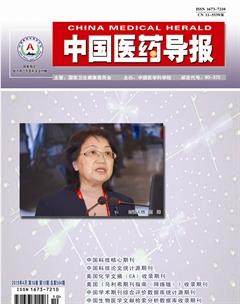脊髓背角P物質、ERK1/CREB信號通路激活在大鼠椎間盤源性內臟痛形成機制中的作用
唐元章 孫晨力 郭玉娜
[摘要] 目的 探討大鼠自體退變髓核注射導致椎間盤源性內臟痛的發生機制。 方法 將24只雄性SD大鼠按照隨機數字表法分為空白對照組、假手術組、髓核注射組,每組8只。髓核注射組大鼠在X線下行右側腰交感干自體退變髓核懸液注射,假手術組注射同等劑量生理鹽水,空白對照組不做任何處理。注射后14 d收集各組大鼠L1~3脊髓節段,采用免疫印跡法半定量分析P物質(SP)和細胞外調節蛋白激酶1/2(ERK1/2)、p-ERK1/2和cAMP反應元件蛋白(CREB)、p-CREB表達的變化。 結果 髓核注射組大鼠脊髓SP及p-ERK1、p-CREB表達較假手術組及空白對照組明顯增多(P < 0.05),三組p-ERK2表達比較,差異無統計學意義(P > 0.05)。 結論 大鼠自體退變髓核注射導致椎間盤源性內臟痛的產生可能與相應脊髓節段SP釋放及ERK1/CREB磷酸化信號傳導通路的激活有關。
[關鍵詞] 脊髓背角;內臟痛;椎間盤;大鼠;信號通路
[中圖分類號] R338.21 [文獻標識碼] A [文章編號] 1673-7210(2019)04(a)-0007-04
Effect of substance P and ERK1/CREB signaling pathway activation in spinal dorsal horn on the mechanism of discogenic visceral pain development in rats
TANG Yuanzhang SUN Chenli GUO Yu′na YANG Liqiang WU Baishan WEI Ya NI Jiaxiang▲
Department of Pain Management, Xuanwu Hospital, Capital Medical University, Beijing 100053, China
[Abstract] Objective To investigate the molecular mechanisms of discogenic visceral pain resulted from autologous degenerative nucleus pulposus (NP) injection. Methods A total of 24 male SD rats were divided into na?觙ve group (n = 8), sham group (n = 8) and NP-treated group (n = 8) according to random number table method, with 8 rats in each group. Under fluoroscopic, autologous degenerative NP suspension was injected into right sympathetic trunk of rats in NP-treated group and the same dose of saline was administrated to right sympathetic trunk of animals in sham group, while the rats in the na?觙ve group did not receive any treatment. After 14 days postoperatively, the expression of substance P (SP), extracellular regulated protein kinases 1/2 (ERK1/2), p-ERK1/2, cyclic AMP response element binding protein (CREB) and p-CREB in the L1-L3 spinal cord of each group was analyzed by Western blot. Results The SP, p-ERK1, p-CREB expression in NP-treated group was significantly increased compared with those in na?觙ve group and control group (P < 0.05), while there was no significant difference in p-ERK2 expression among the three groups (P > 0.05). Conclusion The development of discogenic visceral pain induced by autologous degenerative NP injection is concerned with SP release and p-ERK1/CREB signaling pathway activation.
[Key words] Spinal dorsal horn; Visceral pain; Intervertebral disc; Rat; Signaling pathway
椎間盤前突出導致的交感神經炎癥是頑固性內臟痛的原因,稱為“腰椎間盤源性內臟痛”[1],采取連續腰交感神經抗炎治療消除神經炎癥,取得了確定的治療效果。為了更好地揭示該疾病的機制,有研究采用大鼠自體退變髓核懸液交感神經干注射,證實了退變髓核可導致腰交感神經干炎癥的形成[2]。脊髓P物質(substance P,SP)的釋放和細胞外調節蛋白激酶(extracellular regulated protein kinases,ERK)、cAMP反應元件蛋白(cyclic AMP response element binding protein,CREB)磷酸化傳導通路的激活會導致疼痛的形成,因此可以作為標志性物質來反映疼痛的形成[3-5]。因此,本研究擬采用大鼠椎間盤源性內臟痛模型,探討腰交感神經干炎癥對脊髓SP釋放及ERK/CREB疼痛信號傳導途徑的影響,揭示椎間盤源性內臟痛的產生機制。
1 材料與方法
1.1 主要試劑
抗ERK1/2(ab17942)、p-ERK1/2(ab76165)、CREB(ab32515)、p-CREB(ab32096)抗體購于美國Abcam公司;抗SP抗體購于美國Santa Cruz(sc-9758)公司;造影劑(omnipaque-180 dye)購于通用電氣藥業(上海)有限公司。
1.2 實驗動物及分組
實驗動物為8~10周的雄性SD大鼠,體重250~300 g,由北京維通利華實驗動物中心提供,動物質量合格證號:SCXK(京)2016-0006。所有實驗動物適應環境3 d后進入實驗。將24只大鼠按照隨機數字表法分為空白對照組(na?觙ve組)、假手術組(sham組)和髓核注射組(NP-treated組),每組8只。
1.3 動物模型制作
本研究設計及流程經首都醫科大學宣武醫院倫理委員會審議通過。按照之前本課題組報道進行自體退變髓核腰交感干注射建立椎間盤源性內臟痛模型[2],穿刺位置確定后,緩慢注射預先準備的Co4/5到Co8/9椎間盤髓核的0.5 mL髓核混懸液于腰交感干周圍。注射完畢后,緩慢退針,穿刺點局部壓迫止血。sham組腰交感干周圍同樣方法注射0.5 mL生理鹽水。na?觙ve組不行任何處理。
1.4 免疫印跡
各組大鼠在腰交感干注射后14 d采用Western blot法檢測脊髓L1~3節段SP、ERK1/2、p-ERK1/2、CREB和p-CREB的含量。各樣本于液氮中取出,先放入勻漿液中低溫勻漿,4℃靜置10 min,加入90 μL NP-40(10%)后劇烈振蕩30 s,4℃ 800 g離心15 min,取上清,即為胞漿蛋白。按lowry法測定樣本蛋白濃度后加入4倍樣本緩沖液,95℃ 5 min變性,等量的樣本加在10%硝酸纖維素膜上,3%牛血清封閉3 h后分別給予多克隆兔抗p-ERK1/2、ERK1/2抗體(1∶1000),多克隆兔抗CREB、p-CREB(1∶1000),多克隆羊抗SP(1∶200),4℃孵育過夜,TBST沖洗,3×15 min,加入堿性磷酸酶標記二抗(1∶1000),室溫振蕩孵育2 h,TBST沖洗,3×15 min,用NBT/BCIP顯色反應條帶,圖像分析軟件(Labworks software,Uvp Upland,CA,美國)分析條帶灰度值,光密度法半定量分析數據。
1.5 統計學方法
采用SPSS 17.0軟件進行統計分析。計量資料以均數±標準差(x±s)表示,單因素方差分析用于三組間比較,組間兩兩比較采用Dunnett-t法。以P < 0.05為差異有統計學意義。
2 結果
大鼠自體退變髓核腰交感干注射后14 d,NP-treated組大鼠脊髓SP含量(圖1A)、p-ERK1含量(圖1B)及p-CREB含量(圖1C)較na?觙ve組和sham組升高(P < 0.05)。但是三組p-ERK2含量比較,差異無統計學意義(P > 0.05)。
3 討論
椎間盤突出癥是臨床上較為常見的脊柱疾病之一,髓核漏出引起的脊神經炎癥椎間盤后突出導致的脊神經根痛性癥狀的主要原因[6];而部分頑固型內臟痛患者可在腰椎核磁影像上發現椎間盤前突出及腰交感神經干炎癥影像,稱之為“椎間盤源性內臟痛”。我們在前期研究中應用CT引導下腰交感干置管,連續抗炎治療椎間盤源性內臟痛患者,取得了明顯效果[1],并在大鼠盤源性內臟痛模型中,證實了椎間盤源性內臟痛的交感神經炎癥機制[2]。
本研究進一步驗證了椎間盤源性內臟痛的脊髓痛覺信號傳導通路。結果顯示,腰交感干注射后14 d,NP-treated組大鼠脊髓SP、p-ERK1、p-CREB含量較na?觙ve組及sham組升高,但是三組p-ERK2含量比較差異無統計學意義。
SP是中樞神經系統內疼痛的重要調質和遞質,它被認為是脊髓傷害性信息的傳遞物質[7-8],可以用SP作為疼痛發生的標志物來推測疼痛的發生。ERK分為ERK1和ERK2,統稱為ERK1/2,是絲裂原活化蛋白激酶(mitogen-activated protein kinase,MAPK)信號通路成員之一。ERK主要分布于胞漿,磷酸化后的ERK起到將胞外信號傳到核內的介導作用。近年來發現磷酸化ERK引起CREB的磷酸化激活(p-CREB),在炎性痛敏的產生和維持中發揮了關鍵作用[9-10]。在多種疼痛模型(辣椒素或完全弗氏佐劑致炎、內臟痛、電刺激等)中發現ERK信號通路參與脊髓水平傷害性信號調制和中樞敏感化的形成[11-15],而ERK激活引起CREB磷酸化核內轉位誘導新的突觸形成及多種因子、受體表達是主要途徑之一[16-18]。因此,ERK1/2-CREB的磷酸化激活(p-ERK1/2)已經作為疼痛標志物來反映疼痛的形成[13]。
既往對于疼痛刺激的研究顯示,ERK1/2磷酸化信號傳導途徑多呈同向變化,但是,近年來發現,ERK1和ERK2兩種信號途徑可能有不同的功能,ERK1和ERK2細胞內信號傳導途徑對于Ras依賴性細胞的信號傳導和增殖有不同的作用,ERK2對于促進Ras依賴性細胞的增殖有促進作用,但是ERK1可以影響整個信號傳導途徑抑制ERK2的激活,影響細胞增殖[19]。后來又有研究者證實ERK1和ERK2分子結構N端的不同造成了信號傳導途徑的差異,進而影響細胞增殖及突觸可塑性變化等[20]。在關于疼痛方面的研究中,Cheng等[21]發現在雌激素缺乏的大鼠中,間質性膀胱炎(內臟痛)可使ERK1磷酸化增多,但是對于ERK2磷酸化沒有影響。本研究結果和他們的發現類似,髓核懸液交感干注射引起的交感神經炎性內臟痛使ERK1磷酸化明顯增多,對ERK2磷酸化無影響,而且ERK1和ERK2的總量表達沒有增多。雖然機制不清,但是或許提示ERK1/2信號通路的激活在內臟痛產生過程中有不同的作用。
腰交感干注射后14 d,脊髓SP和p-ERK1、p-CREB表達明顯增多,我們推測:通過髓核注射使腰交感干產生炎癥后,長時間重復的炎癥刺激及異位電活動可導致脊髓釋放大量的傷害性神經遞質或調質如SP等,從而觸發一系列胞內信號通路的級聯反應,例如ERK1的磷酸化,使疼痛信號傳至細胞內,轉錄因子(CREB)磷酸化而調節轉錄活性并影響蛋白質的合成最終在細胞水平表現為脊髓神經元的敏感化,導致痛覺傳導通路及激活。
本研究結果提示:大鼠自體退變髓核腰交感注射導致交感神經炎癥,可誘導脊髓SP釋放及ERK1/CREB磷酸化信號傳導通路的激活。提示SP釋放及ERK1/CREB磷酸化信號傳導通路參與了椎間盤源性內臟痛的形成,為椎間盤源性內臟痛的治療選擇新靶點提供了理論依據。
[參考文獻]
[1] Tang YZ,Shannon ML,Lai GH,et al. Anterior herniation of lumbar disc induces persistent visceral pain:discogenic visceral pain:discogenic visceral pain [J]. Chin Med J(Engl),2013,126(24):4691-4695.
[2] 卞晶晶,唐元章,武百山,等.大鼠退變髓核腰交感神經干注射對交感神經干炎癥因子表達的影響[J].中國實驗診斷學,2014,18(10):1567-1570.
[3] Hughes JP,Chessell I,Malamut R,et al. Understanding chronic inflammatory and neuropathic pain [J]. Ann N Y Acad Sci,2012,1255:30-44.
[4] Li ZY,Huang Y,Yang YT,et al. Moxibustion eases chronic inflammatory visceral pain through regulating MEK,ERK and CREB in rats [J]. World J Gastroenterol,2017, 23(34):6220-6230.
[5] Henry JL. Future basic science directions into mechanisms of neuropathic pain [J]. J Orofac Pain,2004,18(4):306-310.
[6] de Souza Grava AL,Ferrari LF,Defino HL. Cytokine inhibition and time-related influence of inflammatory stimuli on the hyperalgesia induced by the nucleus pulposus [J]. Eur Spine J,2012,21(3):537-545.
[7] Millan MJ. The induction of pain:an integrative review [J]. Prog Neurobiol,1999,57(1):1-164.
[8] V Euler US,Gaddum JH. An unidentified depressor substance in certain tissue extracts [J]. J Physiol,1931,72(1):74-87.
[9] Miletic G,Pankratz MT,Miletic V. Increases in the phosphorylation of cyclic AMP response element binding protein(CREB)and decreases in the content of calcineurin accompany thermal hyperalgesia following chronic constriction injury in rats [J]. Pain,2002,99(3):493-500.
[10] Ji RR,Befort K,Brenner GJ,et al. ERK MAP kinase activation in superficial spinal cord neurons induces prodynorphin and NK-1 upregulation and contributes to persistent inflammatory pain hypersensitivity [J]. J Neurosci,2002,22(2):478-485.
[11] Wang H,Dai Y,Fukuoka T,et al. Enhancement of stimulation-induced ERK activation in the spinal dorsal horn and gracile nucleus neurons in rats with peripheral nerve injury [J]. Eur J Neurosci,2004,19(4):884-890.
[12] Aley KO,Martin A,McMahon T,et al. Nociceptor sensitization by extracellular signal-regulated kinases [J]. J Neurosci,2001,21(17):6933-6999.
[13] Ji RR,Gereau RW,Malcangio M,et al. MAP kinase and pain [J]. Brain Res Rev,2009,60(1):135-148.
[14] Luo X,Fitzsimmons B,Mohan A,et al. Intrathecal administration of antisense oligonucleotide against p38alpha but not p38beta MAP kinase isoform reduces neuropathic and postoperative pain and TLR4-induced pain in male mice [J]. Brain Behav Immun,2017. [Epub ahead of print]
[15] Wu XB,Cao DL,Zhang X,et al. CXCL13/CXCR5 enhances sodium channel Nav1.8 current density via p38 MAP kinase in primary sensory neurons following inflammatory pain [J]. Sci Rep,2016,6:34-36.
[16] Kim Y,Kwon SY,Jung HS,et al. Amitriptyline inhibits MAPK/ERK,CREB pathway and proinflammatory cytokines through A3AR activation in rat neuropathic pain models [J]. Korean J Anesthesiol,2018. [Epub ahead of print]
[17] Liu S,Liu YP,Huang ZJ,et al. Wnt/Ryk signaling contributes to neuropathic pain by regulating sensory neuron excitability and spinal synaptic plasticity in rats [J]. Pain,2015,156(12):2572-2584.
[18] Liu S,Liu YP,Yue DM,et al. Protease-activated receptor 2 in dorsal root ganglion contributes to peripheral sensitization of bone cancer pain [J]. Eur J Pain,2014, 18(3):326-337.
[19] Vantaggiato C,Formentini I,Bondanza A,et al. ERK1 and ERK2 mitogen-activated protein kinases affect Ras-dependent cell signaling differentially [J]. J Biol,2006,5(5):14-22.
[20] Marchi M,D'Antoni A,Formentini I,et al. The N-terminal domain of ERK1 accounts for the functional differences with ERK2 [J]. PLoS One,2008,3(12):e3873.
[21] Cheng Y,Keast JR. Effects of estrogens and bladder inflammation on mitogen-activated protein kinases in lumbosacral dorsal root ganglia from adult female rats [J]. BMC Neurosci,2009,10:156-163.
(收稿日期:2018-06-19 本文編輯:張瑜杰)

